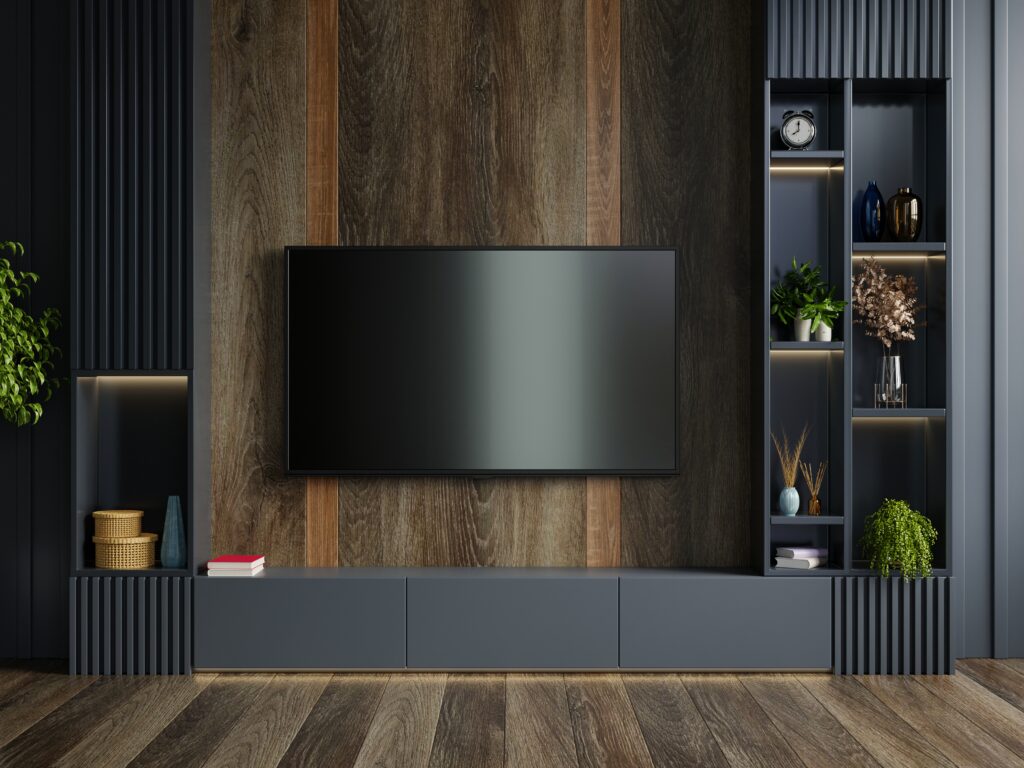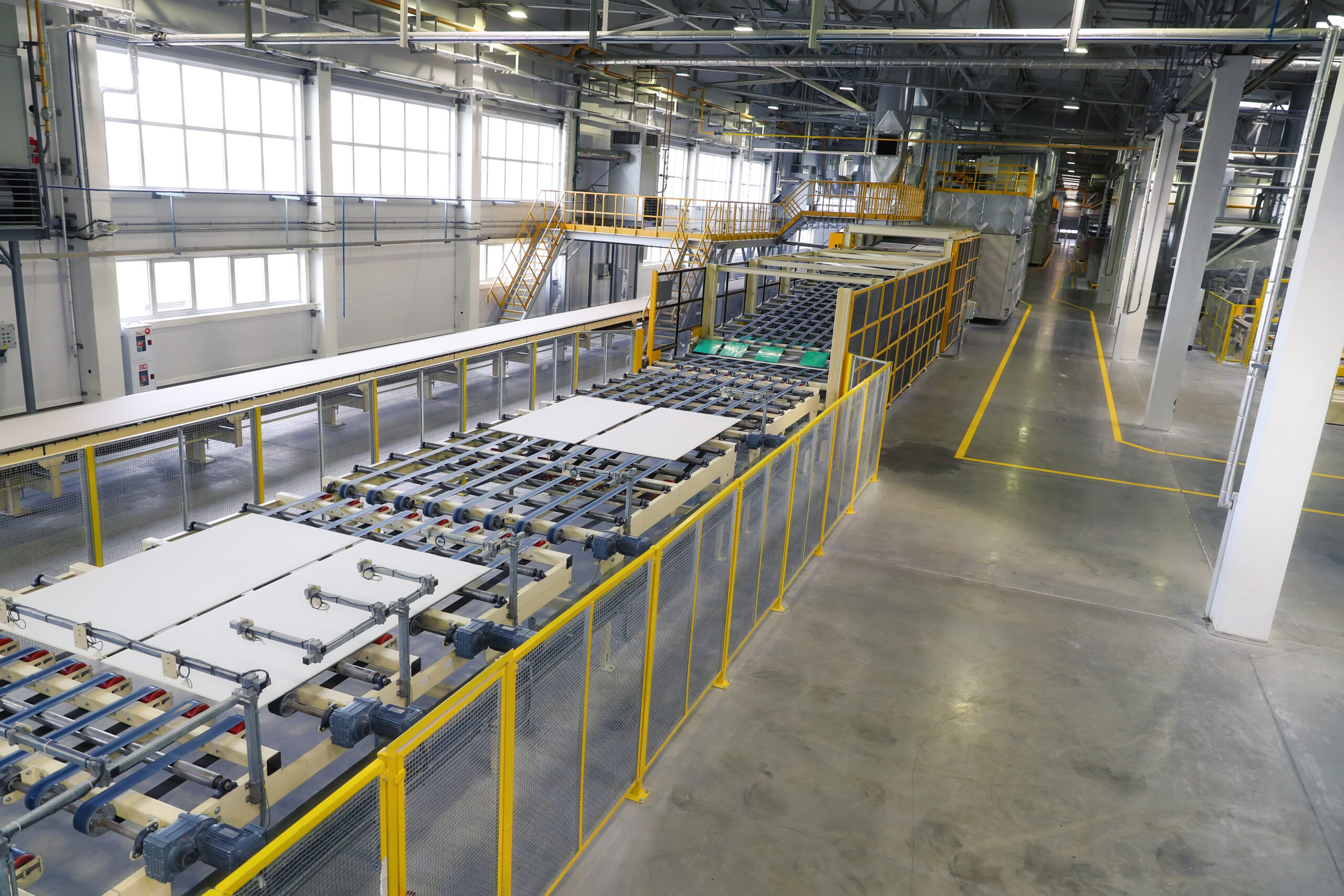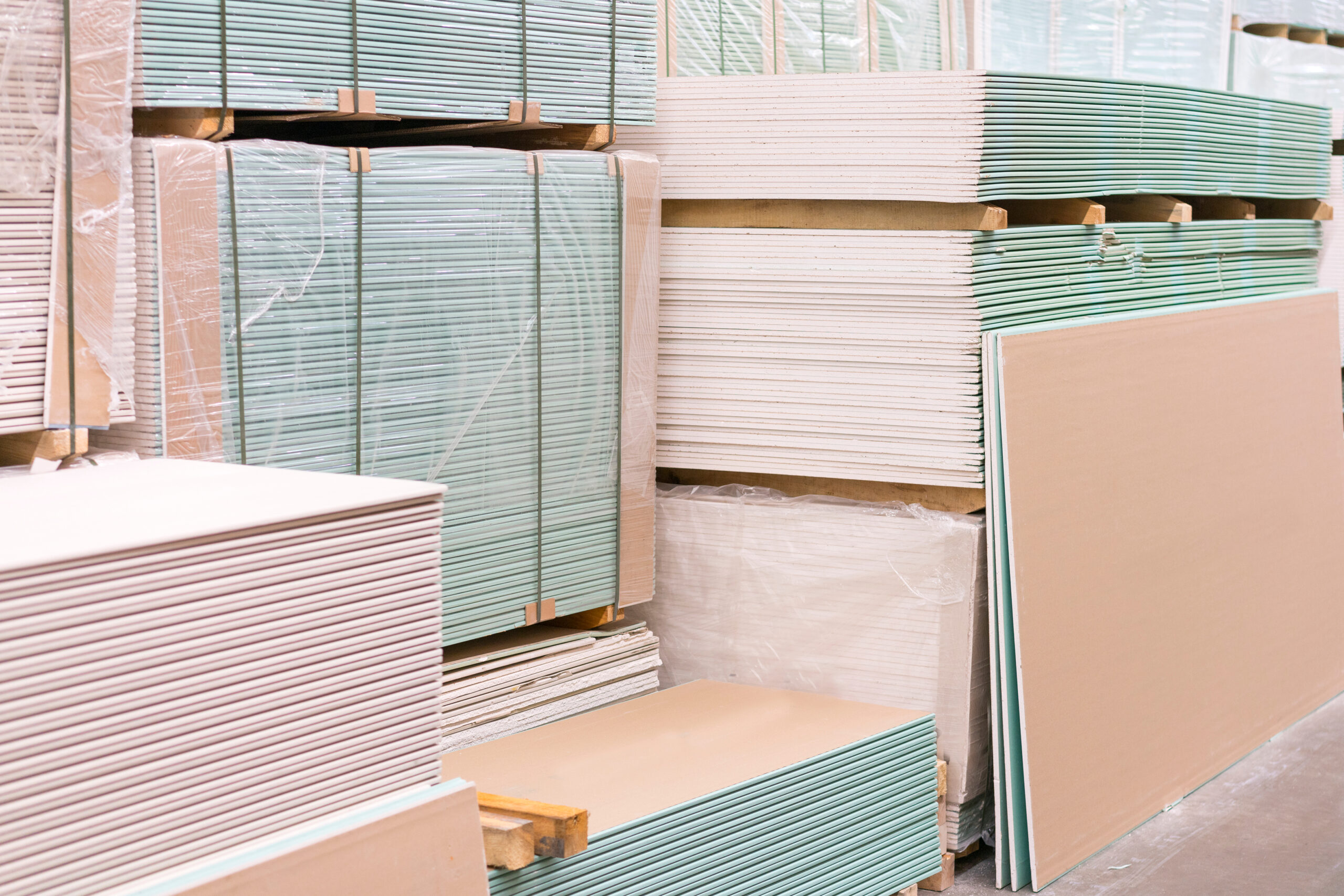Fire Rated Plasterboard
(11 Products)Your home is your safe place; make sure it's safe with fire-rated plasterboard. Fire-rated plasterboard goes by many names: fire-resistant plasterboard, fireproof plasterboard, fire board, or pink plasterboard (due to the colour of its paper face). Fire-rated does not mean that this is completely fireproof plasterboard, merely that it has fire resistance.
BULK SAVING
12.5mm Knauf Fire Panel Tapered Edge Plasterboard 2400mm x 1200mm - Pallet of 60
BULK SAVING
12.5mm Knauf Fire Panel Square Edge Plasterboard 2400mm x 1200mm - Pallet of 60
What is Fire Rated Plasterboard?
Fire-rated plasterboard goes through a special process that is different from the manufacture of standard plasterboard; its aerated gypsum core is reinforced with glass fibre and other elements before being strongly sealed to the pink paper that sees many people refer to it as “pink plasterboard”.
The glass fibres and different additives added to the mix confer both strength and additional fire resistance to the finished boards, making them fire retardant. This is an important thing to note, as even fire-resistant plasterboard can only contain and withstand fire for a relatively short time of 30 minutes, but it is hoped that the use of fire and smoke alarm technology will buy enough time to evacuate residents. This is why they are referred to as fire-resistant boards rather than fireproof plasterboard.
What is Fire Rated Plasterboard Used For?
Installing fire-rated plasterboard helps to meet UK building regulations in a variety of wall lining and ceiling systems, such as fire-rated partitions, stud partitions, domestic separating walls, and steel encasement systems.
- Used to make buildings safer and less at risk if a fire breaks out
- An excellent way to delay the spread of fire through the building
- Doesn't contribute much to the thermal retention of the buildup (with a thermal conductivity of 0.24 W/mK)
- Mainly used for dry lining and fire resistance purposes
Benefits
- Fire Protection: Its primary benefit is providing a significantly increased period of fire resistance compared to standard plasterboard, crucial for compartmentation strategies.
- Delayed Fire Spread: It effectively slows the progression of flames, heat, and smoke, protecting escape routes and containing fire to specific areas.
- Structural Integrity Protection: By maintaining integrity and slowing heat transfer, it buys vital time for load-bearing structures to remain stable, preventing premature collapse.
- Safety: The extended fire resistance directly contributes to allowing occupants more time to safely evacuate the building.
- Building Regulations Compliance: Essential for meeting the fire safety requirements outlined in national and local building regulations (e.g., Approved Document B in the UK).
- Versatility: Available in various thicknesses and sizes, making it suitable for a wide range of applications from walls and ceilings to structural encasement.
- Ease of Use: While denser than standard plasterboard, it can still be cut, fixed, and finished using conventional drywall techniques, making installation efficient.
- Clear Identification: The characteristic pink paper facing makes it easily identifiable on-site, ensuring correct material use.
How Fire-Rated Plasterboard Works
The enhanced fire resistance of fire-rated plasterboard is a result of both its composition and its unique thermal behaviour when exposed to high temperatures:
- Calcination (Dehydration): When fire heat penetrates the board, the chemically bound water within the gypsum core begins to evaporate, converting into steam. This process, known as calcination, is endothermic, meaning it absorbs a large amount of heat energy (around 2260 kJ/kg). Crucially, the temperature of the gypsum core remains at approximately 100°C (the boiling point of water) until all the water has evaporated. This provides a significant period of temperature stabilisation on the side of the board facing away from the fire, protecting the underlying structure and materials.
- Formation of Calcined Layer: As the water is driven off, the gypsum transforms into calcium sulphate hemihydrate and eventually calcium sulphate anhydrite. This dehydrated gypsum retains some structural integrity.
- Glass Fibre Reinforcement: The embedded glass fibres act as a vital skeletal structure. Even after the gypsum has fully dehydrated and softened, these fibres help to hold the board's integrity, preventing it from crumbling and falling away prematurely. This maintains the physical barrier against flame and hot gases.
- Low Thermal Conductivity of Calcined Gypsum: The calcined gypsum layer itself has naturally low thermal conductivity. Coupled with the porous microstructure created by the water release, this provides an additional insulating barrier that further limits the temperature rise on the unexposed side.
- Multi-Layer Systems: In many applications requiring higher fire ratings (e.g., 60 minutes, 90 minutes, or 120 minutes), fire-rated plasterboard is installed in multiple layers. The staggered joints and successive layers mean that as one layer calcines, the next layer remains intact, creating a continuous protective shield and extending the period of fire resistance. Each layer contributes to a progressive temperature gradient across the board thickness, absorbing energy sequentially.
Fire Resistance Ratings and Standards
Fire resistance ratings are not assigned to individual plasterboard sheets in isolation but to complete systems (e.g., a partition wall comprising plasterboard, framing, insulation, and jointing materials) that have been tested in laboratories.
- Fire Resistance Period (Minutes): This indicates the minimum time (e.g., 30, 60, 90, 120 minutes) that a building element can withstand exposure to fire while maintaining its key performance criteria:
- Integrity (E): The ability to contain the fire and prevent the passage of flames and hot gases.
- Insulation (I): The ability to restrict the temperature rise on the unexposed side.
- Loadbearing Capacity (R): For structural elements, the ability to continue carrying its load during the fire.
- A typical rating might be REI 60, meaning it maintains loadbearing, integrity, and insulation for 60 minutes. For non-loadbearing partitions, it might be EI 60.
- European Standards (Euroclass - BS EN 13501-1): This system classifies the reaction to fire performance of building products. Fire-rated plasterboard will often achieve classifications like:
- A1: Non-combustible (e.g., some specialist high-performance fireboards).
- A2-s1, d0: Limited combustibility, very limited smoke production (s1), no flaming droplets (d0).
- This is distinct from the fire resistance period, as it describes how the material itself contributes to a fire, rather than how long it can resist a fire as part of an assembly.
- British Standards (BS 476 series): Historically used in the UK, these standards classify:
- BS 476-20/21: Fire resistance of elements of construction.
- BS 476-6: Fire propagation.
- BS 476-7: Surface spread of flame (Class 1-4, where Class 1 is the best).
It is crucial to follow the manufacturer's specific system guidelines and installation details for each fire-rated plasterboard product to achieve the stated fire resistance rating. Deviations can compromise the system's performance.
Service Penetrations and Perimeter Seals
These are the most common points of failure in fire-rated systems.
- Service Penetrations (Sockets, Pipes, Ducts): Any opening in a fire-rated system for services must be fire-stopped to the same fire rating as the partition or ceiling.
- Use intumescent collars around plastic pipes.
- Use intumescent wraps for smaller pipes or cables.
- Fill gaps around metal pipes and cables with fire-rated mastic sealant or fire-rated mineral wool packed tightly and sealed.
- For electrical sockets, use fire-rated socket boxes or intumescent pads/gaskets behind standard boxes. Avoid back-to-back sockets in fire-rated walls unless a tested fire-stopping solution is used between them.
- Crucially, fire-stopping solutions must be tested and approved for the specific type and size of penetration and the fire rating of the element. Always refer to the fire-stopping product manufacturer's data sheets.
- Perimeter Sealing (Wall-to-Floor, Wall-to-Ceiling, Wall-to-Wall): All junctions where the fire-rated plasterboard system meets adjacent elements must be sealed to maintain the fire compartmentation.
- Use fire-rated acoustic or intumescent sealant to create a continuous seal.
- For junctions that might experience movement (e.g., deflection heads in metal stud walls), specialised deflection head details with intumescent strips are required.
- Access Panels and Fire Doors: If integrating fire-rated access panels or fire doors, ensure they are also fire-rated to the same standard as the partition and are installed strictly according to their manufacturer's instructions, including specific frame requirements and intumescent seals.
Frequently Asked Fire Rated Plasterboard Questions
Is Standard Plasterboard Fire-Resistant?
Standard gypsum plasterboard is not fire rated and this means it will not meet the stringent fire performance requirements of current UK building regulations.
Fire-rated plasterboard offers superior fire resistance over and above that of standard plasterboard and is therefore used widely across a large number of residential and commercial projects.
It is often the case that junction boxes and rooms with electrical equipment are constructed using fire-resistant plasterboard as this allows the spread of the fire to be contained for a period of time to allow safe evacuation or action to extinguish the fire.
What Is The Fire Rating of Pink Plasterboard?
The effectiveness of fire-rated plasterboard is measured by the amount of time it resists fire before burning. As it is not fireproof, merely fire-resistant, pink plasterboard should not be relied on solely to prevent the spread of fire, but merely to halt it temporarily. Other products – such as insulation that is classed as A1 non-combustible – should be used in conjunction with fire-resistant plasterboard to add additional fire protection.
- When used in a partition or ceiling, two layers of 12.5mm fire plasterboard should provide up to one hour’s fire protection
- In a partition where there are two layers of fire-rated plasterboard on either side, they will provide up to two hours of fire resistance
You should always check with an architect or other suitable professional when assessing the level of fire protection required for a building.
Can You Paint Fire Rated Plasterboard?
Yes, paint can either be applied directly to the fire plasterboard or it can be plastered and then painted. For maximum efficacy, intumescent fire-rated paint can be used to maintain its fire protection. This will help to increase the effectiveness of the fire resistance and is also something that can be applied to non-fire-resistant panels in order to give them a measure of fire resistance.
Can I Use Standard Jointing Compound And Tape With Fire-Rated Plasterboard?
No, for all fire-rated plasterboard applications, you must use fire-rated jointing compound and specific jointing tape as specified by the manufacturer. Standard jointing compounds and tapes are not designed to withstand the high temperatures and stresses encountered during a fire event.
- Fire-Rated Joint Compound: This compound is formulated with additives that contribute to the fire resistance of the joint. It is designed to maintain its integrity and adhesion even as the plasterboard calcines and undergoes chemical changes in a fire.
- Jointing Tape: The type of jointing tape is a critical component of the fire-rated system. While various tapes exist for standard plasterboard (such as fibreglass mesh or paper tape), for fire-rated applications, you must use the specific jointing tape that has been tested and approved as part of the manufacturer's fire-rated system. This tape, which could be paper, certain types of fibreglass, or a specialist product, is selected for its ability to maintain integrity and provide essential reinforcement to the jointing compound under fire conditions. It works in conjunction with the fire-rated compound to prevent cracking, tearing, or burning through, thus maintaining the continuous fire barrier.
The precise application method, including the number of coats and the width of the compound application over the tape, is also critical and must follow the manufacturer's tested system details to ensure the joint provides the same level of fire resistance as the rest of the board. Neglecting this crucial detail creates a significant weak point in your fire barrier.
How Does Multi-Layer Installation Improve Fire Protection?
Multi-layer installation significantly enhances fire protection by creating a more robust, redundant, and extended fire barrier within the system. When higher fire ratings (e.g., 90 minutes, 120 minutes, or more) are required, fire-rated plasterboard is typically installed in two or more layers.
Here's how it improves performance:
- Progressive Calcination: As the side exposed to fire heats up, the first layer of plasterboard undergoes calcination (releasing its chemically bound water and absorbing heat). While this is happening, the inner layers remain relatively cool and intact. Only after the first layer has fully dehydrated and its protective function diminishes does the heat begin to significantly affect the next layer, which then begins its own calcination process. This sequential process absorbs heat over a longer period.
- Staggered Joints: Crucially, the joints between successive layers are staggered (offset both horizontally and vertically). This means that a fire cannot find a continuous path through the joints from one layer to the next. As one layer's joint might be vulnerable, it's covered and protected by the solid, unjointed area of the next layer. This "labyrinth" effect significantly increases the time it takes for fire and hot gases to penetrate the assembly.
- Increased Mass and Integrity: More layers mean greater mass, which acts as a better thermal mass to absorb heat. The multiple layers also provide enhanced mechanical stability, helping the system maintain its structural integrity for longer under fire conditions, even if parts of the outer layers begin to degrade.
Where To Use Fire Resistant Plasterboard?
There are several places where using fire-resistant plasterboard makes a lot of sense.
- One is the kitchen in the property, particularly in the walls, floors and ceilings around the main cooking appliance
- It is also good to use near junction boxes or anywhere that could realistically spark an electrical fire
- It is also vital to use it on any structural elements such as floors, walls and supporting beams
It is important to consider all of the places where it may be useful to install fire-rated plasterboard, especially in higher-risk areas, so that the maximum level of fire safety can come as standard with the project you are working on.

.jpg)










